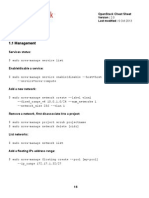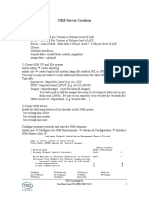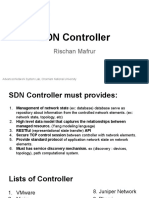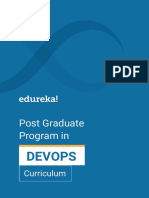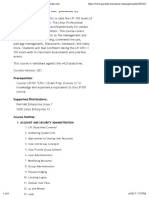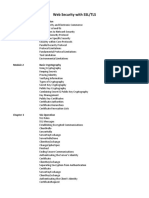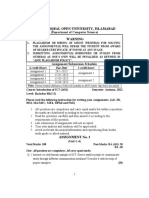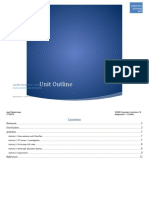FastTrack To Red Hat Linux 7 System Administrator
Uploaded by
Mangesh AbnaveFastTrack To Red Hat Linux 7 System Administrator
Uploaded by
Mangesh AbnaveFastTrack to Red Hat Linux 7 System
Administrator
Overview:
This highly practical instructor led FastTrack to Red Hat Linux 7 System Administrator course is designed to give
experienced LINUX/UNIX administrators practical experience in the administration of a LINUX system to a level
required by the Red Hat Certified Systems Administration certification. This course is targeted to closely follow
the official Red Hat curriculum and will enable the student to work towards the RHCSA qualifications. This class
will have a high, practical content and a fast pace. Delegates should have a strong command line experience of
UNIX/LINUX including cp, grep, mkdir, ssh, tar, useradd, cups, be capable of using man pages and DHCP, to name
just a few. This course can also be used as a practical refresher course prior to taking the RHCSA examination.
Pre-Requisites:
This course assumes a strong prior knowledge of the LINUX/UNIX operating system. The content of the
Administering Red Hat Linux 7 - Part 1 course is the minimum level of knowledge required for attendance on this
course. Delegates should be experienced Linux/UNIX Administrators.
Duration:
7 days
Modules:
Course Introduction
Administration and Course Materials
Course Structure and Agenda
Delegate and Trainer Introductions
Session 1: ACCESSING THE SYSTEM
Logging in and command line access
Getting Help - man pages, info, /usr/share/doc
Sources of information available on the WEB
Remote Desktop Access
Session 2: BASIC CLIENT NETWORKING
Configuring Network Interfaces
Controlling Network Devices: ifup/ifdown
Configuring IPV4 dynamic and static networking
Network Tools ifconfig, ethtool etc
Configuring basic NTP
Connecting NIS and LDAP clients to corresponding servers
Linking to a system using ssh and rsync
Exercise
Session 3: USER AND FILE ADMINISTRATION
Authentication policies and User Private Groups
Password management using passwd, chage etc
Managing user profile files
Extended file permissions including suid, sgid
Access Control List (ACL's)
Switching to another user
Connecting to a centralized administration server
Exercise
Session 4: SYSTEM MONITORING
Monitor CPU and memory usage
Check disk utilization
System Log Files
Monitor system logs
rsyslogd
Analyzing and rotating log files
Exercise
Session 5: SOFTWARE MANAGEMENT
The Red Hat Package Management system
Installing removing software manually using rpm
RPM queries and verifying packages
Dependency problems and resolution
Updating the Kernel from RPM's
Other RPM features
Exercise
Session 6: MANAGING SOFTWARE WITH YUM
The YUM management tool
Software repositories
Accessing repositories from a client
Updating your system with Red Hat Network
Session 7: DATA SECURITY
SELinux
Management of SELinux
Easy configuration and customization of SELinux
Configuring and using ssh and scp
Basic Firewall management
Exercise
Session 8: DISK PARTITIONING
Understand and configure disk partitioning
LUKS encrypted partitions
Exercise
Session 9: LVM VOLUMES
Basic LVM design and configuration
The Logical Volume Manager (LVM)
Creating LVM file systems
Resizing LVM file systems
LVM Snapshots
Exercise
Session 10: MAINTAINING THE KERNEL
Kernel Design
Dynamic Modules
Loading and removing modules
Using kernel arguments
Changing Tuneable Parameters
Exercise
Session 11: INSTALLING RED HAT LINUX USING KICKSTART
How Kickstart works
Sections within a Kickstart configuration file
Pre and Post Kickstart processing
Creating a Kickstart file
Creating the Linux Install Server
Differing ways of starting a Kickstart installation
Exercise
Session 12: USING SYSTEMD AND CONTROLLING SERVICES
The systemd deamon
Control Services using systemctl etc.
System Shutdown and Reboot management
Session 13: MANAGING VIRTUAL SYSTEMS
Virtualization concepts
Install a KVM virtual system
Checking for supported hardware
Start and shutdown a virtual system
Exercise
Session 14: ACCESSING DATA ON REMOTE SYSTEMS
Configuring client access to an Network File system Server (NFS)
Providing CIFS access
Configuring autofs
Exercise
Session 15: TROUBLESHOORTING
Understanding the boot process
The Rescue Environment
Overriding Boot Levels from grub
Common boot problems and their resolution
Exercise
You might also like
- DEMO-Nagios Certified Professional - CoreNo ratings yetDEMO-Nagios Certified Professional - Core9 pages
- iSCSI The Universal Storage Connection PDFNo ratings yetiSCSI The Universal Storage Connection PDF416 pages
- Building A Powerful FreeBSD Firewall Based On PF and IPFW100% (17)Building A Powerful FreeBSD Firewall Based On PF and IPFW13 pages
- Shodashvarga/ Divisional Charts Judgement Rules100% (1)Shodashvarga/ Divisional Charts Judgement Rules17 pages
- Red Hat Enterprise Linux 6 Administration: Real World Skills for Red Hat AdministratorsFrom EverandRed Hat Enterprise Linux 6 Administration: Real World Skills for Red Hat AdministratorsNo ratings yet
- RHCSA Exam Pass: Red Hat Certified System Administrator Study GuideFrom EverandRHCSA Exam Pass: Red Hat Certified System Administrator Study GuideNo ratings yet
- Red Hat Enterprise Linux 5 Logical Volume Manager AdministrationNo ratings yetRed Hat Enterprise Linux 5 Logical Volume Manager Administration122 pages
- Yet Another Technology Blog.: How To Configure PXE Server in RHEL 6 ?No ratings yetYet Another Technology Blog.: How To Configure PXE Server in RHEL 6 ?6 pages
- Grub2 Commands: Making Persistent Changes To A Grub 2 MenuNo ratings yetGrub2 Commands: Making Persistent Changes To A Grub 2 Menu4 pages
- Part A - V7 Exam Questions: 1. Configure SELINUX50% (4)Part A - V7 Exam Questions: 1. Configure SELINUX43 pages
- Setting Up A Red Hat Enterprise Linux ServerNo ratings yetSetting Up A Red Hat Enterprise Linux Server51 pages
- NIM Server Creation: TSG Consulting Inc One Main Street SE, MPLS MN 55415No ratings yetNIM Server Creation: TSG Consulting Inc One Main Street SE, MPLS MN 554156 pages
- TechSmith-Tutorial Video Script TemplateNo ratings yetTechSmith-Tutorial Video Script Template1 page
- Devops Training Curriculum - Course ContentNo ratings yetDevops Training Curriculum - Course Content4 pages
- AnsibleFest 2019 - Managing Meaningful InventoriesNo ratings yetAnsibleFest 2019 - Managing Meaningful Inventories38 pages
- How To Set Up An FTP Server in Windows Server 2003No ratings yetHow To Set Up An FTP Server in Windows Server 20034 pages
- Difference Between Red Hat Enterprise Linux 6 and 7No ratings yetDifference Between Red Hat Enterprise Linux 6 and 73 pages
- A - Z Linux Commands - Overview With Examples PDFNo ratings yetA - Z Linux Commands - Overview With Examples PDF39 pages
- Deploying Applications With Group PolicyNo ratings yetDeploying Applications With Group Policy12 pages
- Copy/Sync Files and Directory Locally: Some Advantages and Features of Rsync CommandNo ratings yetCopy/Sync Files and Directory Locally: Some Advantages and Features of Rsync Command4 pages
- Learn Well Technocraft - DevOps SyllabusNo ratings yetLearn Well Technocraft - DevOps Syllabus10 pages
- Comprehensive Exploration of Linux CommandsNo ratings yetComprehensive Exploration of Linux Commands7 pages
- SLE221 SLES12 For SAP Applications Course Description PDFNo ratings yetSLE221 SLES12 For SAP Applications Course Description PDF2 pages
- Subversion: Audience: Duration: Subversion IntroductionNo ratings yetSubversion: Audience: Duration: Subversion Introduction3 pages
- Linux KVM Virtualization: Detailed Course Outline: 1. Virtualization BasicsNo ratings yetLinux KVM Virtualization: Detailed Course Outline: 1. Virtualization Basics2 pages
- 1Z0-061 Exam Dumps With PDF and VCE Download (1-15) PDF100% (1)1Z0-061 Exam Dumps With PDF and VCE Download (1-15) PDF13 pages
- Linux Fundamentals Commands For: Created By: Mangesh AbnaveNo ratings yetLinux Fundamentals Commands For: Created By: Mangesh Abnave61 pages
- Vmware Vcloud Director: Install, Configure, Manage V9.XNo ratings yetVmware Vcloud Director: Install, Configure, Manage V9.X2 pages
- Metropolitan Community College Course OutlineNo ratings yetMetropolitan Community College Course Outline6 pages
- S.N.B.P International School: Formative Assessment - 2No ratings yetS.N.B.P International School: Formative Assessment - 22 pages
- S Oracle SuperCluster For System Administrators Ed 2No ratings yetS Oracle SuperCluster For System Administrators Ed 22 pages
- Oracle Redo Log Performance Issues and Solutions: Sun HongdaNo ratings yetOracle Redo Log Performance Issues and Solutions: Sun Hongda8 pages
- Oracle Redo Log Performance Issues and Solutions: Sun HongdaNo ratings yetOracle Redo Log Performance Issues and Solutions: Sun Hongda8 pages
- Immediate download The Substance of Consciousness: A Comprehensive Defense of Contemporary Substance Dualism Brandon Rickabaugh ebooks 2024100% (5)Immediate download The Substance of Consciousness: A Comprehensive Defense of Contemporary Substance Dualism Brandon Rickabaugh ebooks 202466 pages
- 2 Sample For Applying Computer Certificate by EmailNo ratings yet2 Sample For Applying Computer Certificate by Email6 pages
- Eligibility Criteria of Tehsildar (Open Merit) - 231011174541No ratings yetEligibility Criteria of Tehsildar (Open Merit) - 2310111745412 pages
- Yr6 - Math - MA1 - Revision-Term 1-Part 2No ratings yetYr6 - Math - MA1 - Revision-Term 1-Part 27 pages
- Allama Iqbal Open University, Islamabad Warning: (Department of Computer Science)No ratings yetAllama Iqbal Open University, Islamabad Warning: (Department of Computer Science)4 pages
- Preparing For Higher Education Note Taking Guide 2 3 3 l1No ratings yetPreparing For Higher Education Note Taking Guide 2 3 3 l14 pages
- Skillslash Digital Marketing Master Course With Gen-AiNo ratings yetSkillslash Digital Marketing Master Course With Gen-Ai17 pages
- Larsen-Freeman On Teaching Methods and Approaches For Teaching English As A Foreign LanguageNo ratings yetLarsen-Freeman On Teaching Methods and Approaches For Teaching English As A Foreign Language15 pages
- What Are The Expected Tasks You Have Successfully Accomplished67% (18)What Are The Expected Tasks You Have Successfully Accomplished1 page
- 04 The National Tourism Development Strategy and Programs PDFNo ratings yet04 The National Tourism Development Strategy and Programs PDF26 pages
- Consumer Analytics Course Outline - 2024No ratings yetConsumer Analytics Course Outline - 20247 pages
- PDF Quick Access Reference for Writers 6th ed. Edition Lynn Quitman Troyka download100% (3)PDF Quick Access Reference for Writers 6th ed. Edition Lynn Quitman Troyka download71 pages

























